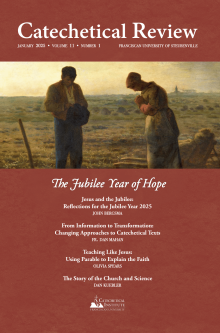
In the contemporary age, when utilitarian aims of education rule alongside individual choice, electives, and test prep, it may come as a surprise that a Catholic school might require each student to participate in a choral music program. A choral program, moreover, that is more than a so-called specials class, more than a diversion in the middle of the school day, more than an easy A. Situated on the campus of the Cathedral of Our Lady of Walsingham in Houston, Texas, Cathedral High School was founded in 2022. Here, music occupies such a central place in the curriculum that it forms one of the four foundational pillars of the school. And it is not the only school of its kind. Across the United States, a movement is taking place to return to the riches of an authentic liberal education.
Catholic schools are once again placing value on the study of the visual and performing arts. The training up of the young person in the art of singing and the study of music is an ancient and highly valued discipline of education. Music, in the great tradition of liberal education, is one of the four mathematical disciplines known together as the quadrivium—on equal footing with arithmetic, geometry, and astronomy. These, alongside the trivium of grammar, logic, and rhetoric, form what is known as the seven liberal arts. “Liberal” here comes from the word “free.” Young minds are freed to truly think, question, and learn in the search for truth.
As Catholics, we know that truth is not a disembodied idea; Truth has a name, and his name is Jesus Christ. The immense task of the Catholic school music teacher is to help form young people to listen, which, when done properly, leads them to hear the Word of God, to know Christ, and to attune their lives to him. Sacred music, as the language of the liturgy, rightly deserves a central place in the life of the Catholic school.
The rest of this online article is available for current Guild members.
[1] United States Conference of Catholic Bishops, Sing to the Lord: Music in Divine Worship (USCCB, 2008), 1.
[2] Cathedral High School, “Curriculum,” https://cathedral-hs.org/curriculum.
[3] St. Benedict, The Rule of St. Benedict, ed. Timothy Fry (Liturgical Press, 2018), 15.
[4] See Everett Ferguson, A Cappella Music in the Public Worship of the Church, 4th ed. (Desert Willow, 2013), 9–10.
[5] This translation of Ps 43 (Vulgate Ps 42) is taken from: Hugo H. Hoever, ed., St. Joseph Daily Missal (B. Herder, 1957).
[6] Second Vatican Council, Sacrosanctum Concilium, no. 112.
[7] See David W. Fagerberg, Theologia Prima: What Is Liturgical Theology? (Liturgy Training Publications, 2012).
[8] Preface I of Easter, in The Roman Missal, 3rd typical ed., (USCCB, 2010), p. 558 (§ 45).
[9] St. Basil the Great, Homily on Psalm 1, in Exegetic Homilies, trans. Agnes Clare Way, Fathers of the Church 46 (Catholic University of America Press, 2003), 152 (emphasis added).
Art Credit: Chorkonzert, signiert und bezeichnet Max Scholz München, Wikimedia Commons.
This article is from The Catechetical Review (Online Edition ISSN 2379-6324) and may be copied for catechetical purposes only. It may not be reprinted in another published work without the permission of The Catechetical Review by contacting [email protected]
















